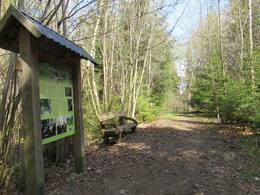The exploits of the villagers of Šarnelė
During World War II, two families from the village of Šarnelė – the Striaupiai and the Kerpauskas – despite mortal danger, saved the lives of Jews. The Striaupiai family saved as many as 26 people, including nine families, and a hiding place was set up in the forest of the Kerpauskas homestead for the family of a Jewish furrier from Alsėdžiai.
The village of Šarnelė in the Plungė district became a quiet but incredibly important island of humanity during the Nazi occupation of World War II. Here, on a remote Samogitian homestead, lived the Striaupiai family – simple peasants who, risking their own lives and those of their loved ones, hid Jews from the war.
The story begins in the Telšiai ghetto. Having learned about the planned massacres, Juozas Striaupys rode alone to Lake Mastis (in Telšiai), where the ghetto was located, and through a sewage well he established contact with three Jewish young men. A few days later, at night, through the same sewage system, he led as many as six people out of the ghetto. At first, a bunker was set up for them in the Striaupyi homestead under the floor of a chicken coop, later - in a hideout in a workshop. During the days, the hideout was quiet, but at night, life was bustling.
Birutė, the daughter of the Striaupiai family, who was still a child at the time, became the eyes and ears of the family. She would signal the approaching Germans with songs from a tree, and would observe the surroundings from a hill. One summer, a search took place on the homestead – the Gestapo searched the house, and the hiding place in the chicken coop was so cleverly camouflaged with manure and straw that the soldiers, having soiled their boots, quickly left. Birutė, although only eight years old, did not give away the secret even when she was shaken, frightened, and tempted with chocolate.
The feat of the Striaupiai did not end there. Having learned that the family of the Jewish furrier Faktor, who lived in Alsėdžiai, was also planned to be sent to the ghetto, Juozas, together with his neighbors Kerpauskas, dug another bunker (underground) in the forest (now on the path of the poet V. Mačernis). 7 family members settled in it, including a pregnant woman who later gave birth to a daughter in that bunker. It was the support of the Kerpauskas and the solidarity of other villagers – from farmers to priests – that helped keep this rescue operation secret for as long as 4 years.
Related topics
Related objects
Vytautas Mačernis Birthplace Trail
In the village of Šarnelė, Plungė district, in the birthplace of the Lithuanian poet Vytautas Mačernis, a path to the poet's birthplace has been established. Walking along this 545 m long path, you will reach the poet's grave. The poet died on October 7, 1944, during the Battle of Seda, when he was accidentally hit in the head by a fragment of an artillery shell. After his death, the poet's relatives returned the deceased back to Šarnelė to be buried in his homeland.
While walking along the V. Mačernis hiking trail, don't miss the nearby Kerpauskas spring and information stand. This spring commemorates an important historical period - the genocide of the Jewish people during World War II. The Kerpauskas spring is located by the path leading from the parking lot to the poet's grave. During World War II, the family of Juozas and Adolfina Kerpauskas hid Jews in underground bunkers installed at the foot of a small hill near the spring and in the homestead below. For three and a half years, the family took care of several Jewish families - 16 people in total - and protected them from destruction. During the Soviet era, Adolfina and Juozas Kerpauskas and their children Bronė and Tomas were deported to Siberia. Juozas Kerpauskas in 1992 and Adolfina Kerpauskienė in 2009 were awarded the Salvation Cross.





